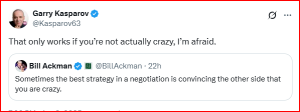
After President Donald Trump unveiled the tariffs on all its trading partners on Wednesday, this economist recalled his analysis of tariffs being used to fund tax cuts. Meanwhile, another senior economist highlighted other possible implications of the tariff announcements.
What Happened: Craig Shapiro, a macro strategist at the Bear Traps Report, reaffirmed his analysis by referring to Trump as the “Tariff man,” and explained how sweeping tariffs on the U.S. trading partners were announced as he had “predicted,” back in February.
“Tariffs plug the hole in the deficit to allow income tax cuts to come,” he said in an X post.
Shapiro, in his old analysis, had argued that Trump’s deficit reduction goal, from 6-7% to 3% of GDP, necessitates tariffs. With entitlement and defense cuts off the table, he contended that tariffs are the only way to fund tax cuts without increasing the deficit.
While many believed that Trump could have backed down on tariffs, Shapiro reiterated that the underlying “math suggests he has no other choice but to use them.”
Shapiro also said that tariffs seek to bring back manufacturing and secure domestic production of critical defense and healthcare items, a policy Trump has advocated for 40 years.
Why It Matters: Apart from the long-term effect that tariffs could have on the economy and how they could align with Trump’s further economic plans, senior economist Mohamed El-Erian highlighted things to look for after Wednesday’s tariff announcements.
He expects a wide range of reactions from the tariffed countries, which could include retaliation, escalation, or a state of paralysis. El-Erian also expects notable revisions in the U.S. and other countries’ growth and inflation projections.
Finally, El-Erian expects business leaders to navigate the tariff barriers to reduce the impact on their businesses.
Claiming a need to address the U.S.’s trade deficit, President Trump invoked a 1977 law to declare a trade emergency and implement new tariffs on Wednesday. Notably, China, Vietnam, Cambodia, and Sri Lanka face the harshest tariffs, while Canada and Mexico were spared. The move spurred a record-breaking gold price rally and a flight to safe-haven investments.
Price Action: The SPDR S&P 500 ETF Trust SPY and Invesco QQQ Trust ETF QQQ, which track the S&P 500 index and Nasdaq 100 index, respectively, fell in premarket on Thursday. The SPY was down 3.36% to $545.54, while the QQQ declined 3.80% to $458.07, according to Benzinga Pro data.
Gold prices were lower by 0.85% at $3,126.02 after scaling a fresh record of $3,167.71 per ounce.
Read Next:
Image via Shutterstock
Momentum65.96
Growth–
Quality–
Value–
Market News and Data brought to you by Benzinga APIs
© 2025 Benzinga.com. Benzinga does not provide investment advice. All rights reserved.



